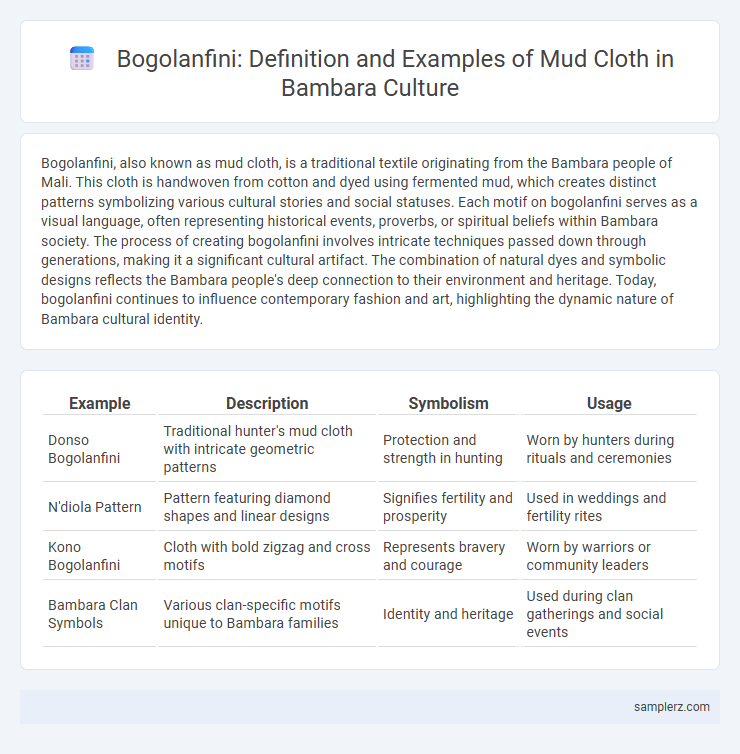Bogolanfini, also known as mud cloth, is a traditional textile originating from the Bambara people of Mali. This cloth is handwoven from cotton and dyed using fermented mud, which creates distinct patterns symbolizing various cultural stories and social statuses. Each motif on bogolanfini serves as a visual language, often representing historical events, proverbs, or spiritual beliefs within Bambara society. The process of creating bogolanfini involves intricate techniques passed down through generations, making it a significant cultural artifact. The combination of natural dyes and symbolic designs reflects the Bambara people's deep connection to their environment and heritage. Today, bogolanfini continues to influence contemporary fashion and art, highlighting the dynamic nature of Bambara cultural identity.
Table of Comparison
| Example | Description | Symbolism | Usage |
|---|---|---|---|
| Donso Bogolanfini | Traditional hunter's mud cloth with intricate geometric patterns | Protection and strength in hunting | Worn by hunters during rituals and ceremonies |
| N'diola Pattern | Pattern featuring diamond shapes and linear designs | Signifies fertility and prosperity | Used in weddings and fertility rites |
| Kono Bogolanfini | Cloth with bold zigzag and cross motifs | Represents bravery and courage | Worn by warriors or community leaders |
| Bambara Clan Symbols | Various clan-specific motifs unique to Bambara families | Identity and heritage | Used during clan gatherings and social events |
Introduction to Bogolanfini in Bambara Culture
Bogolanfini, also known as mud cloth, holds profound cultural significance in Bambara society, serving as a symbol of identity and heritage. This handmade textile is crafted through a meticulous process of dyeing with fermented mud, reflecting ancestral knowledge and spiritual beliefs. Worn during important ceremonies and rituals, bogolanfini embodies the stories and values passed down through Bambara generations.
Historical Origins of Bogolanfini
Bogolanfini, also known as mud cloth, originates from the Bambara people of Mali, where its production dates back centuries as a traditional art form integral to cultural identity. The process involves hand-weaving cotton fabric and dyeing it using fermented mud and natural plant dyes, reflecting a deep connection to the land and ancestral knowledge. Historically, bogolanfini served not only as clothing but also as a symbol of social status, spiritual protection, and storytelling within Bambara communities.
Traditional Techniques of Bogolan Fabric Creation
Bogolanfini, a traditional Malian fabric, is crafted using a time-honored technique involving handwoven cotton dyed with fermented mud. Artisans apply intricate patterns by painting the fabric with natural dyes derived from leaves, bark, and mud, each symbolizing Bamana cultural stories and spiritual beliefs. This method reflects a deep connection to the environment and ancestral knowledge integral to Bambara identity.
Symbolic Meanings in Bogolanfini Patterns
Bogolanfini, the traditional mud-dyed cloth of the Bambara people, is deeply embedded with symbolic meanings expressed through its intricate patterns. Each motif represents cultural symbols such as fertility, protection, and social status, often narrating stories of ancestral heritage and spiritual beliefs. The use of natural dyes and repetitive geometric designs not only exemplifies artistic craftsmanship but also serves as a powerful communication tool within Bambara society.
Notable Examples of Bogolanfini Artifacts
Notable examples of bogolanfini artifacts include intricately patterned mud-dyed textiles from the Bambara people of Mali, revered for their symbolic motifs representing social status and spiritual beliefs. These textiles often feature geometric shapes and animal figures, with each design element conveying deep cultural narratives passed down through generations. Collections held in museums such as the National Museum of Mali showcase bogolanfini's role not only as functional clothing but also as a medium of cultural identity and artistic expression.
Role of Bogolanfini in Bambara Rituals
Bogolanfini, also known as mud cloth, holds profound significance in Bambara rituals, symbolizing protection and ancestral connection through its intricate patterns. Worn during important ceremonies such as initiation rites and funerals, the textile serves as a spiritual conduit linking participants to their cultural heritage. Each motif on the bogolanfini conveys specific meanings, reinforcing communal identity and social status within Bambara society.
Influence of Bogolanfini on Contemporary Fashion
Bogolanfini, the traditional Bambara mud cloth, significantly influences contemporary fashion by inspiring designers to incorporate its distinctive geometric patterns and natural dyes into modern apparel. This artisanal textile embodies cultural heritage, merging history with innovation to create unique, sustainable fashion statements. Its resurgence in global fashion markets highlights the growing appreciation for African craftsmanship and ethical production methods.
Preservation of Bogolanfini Craftsmanship
Bogolanfini, the traditional mudcloth of the Bambara people, embodies cultural identity through its intricate hand-dyeing techniques using fermented mud and natural dyes. Preservation efforts focus on transferring artisanal skills to younger generations in Mali, safeguarding patterns that symbolize historical narratives and social statuses. Museums and cultural centers actively document and promote bogolanfini craftsmanship, ensuring its continuity amid globalization pressures.
Bogolan Artists and Cultural Identity
Bogolan artists in Bambara culture transform traditional mud-dyeing techniques into vibrant expressions of cultural identity. Their intricate patterns symbolize historical narratives and spiritual beliefs, reinforcing community heritage through wearable art. This fusion of craftsmanship and symbolism highlights Bogolan as a vital element in preserving and celebrating Bambara cultural identity.
Bogolanfini’s Impact on Global Textile Art
Bogolanfini, also known as mud cloth, is a traditional Bambara textile renowned for its distinctive hand-dyed patterns created using fermented mud. This ancient art form has significantly influenced global textile art by inspiring contemporary designers and artists, who integrate its symbolic motifs and natural dyeing techniques into modern fashion and home decor. The cultural significance and sustainability of bogolanfini continue to resonate, promoting the preservation of indigenous craftsmanship worldwide.

example of bogolanfini in Bambara Infographic
 samplerz.com
samplerz.com